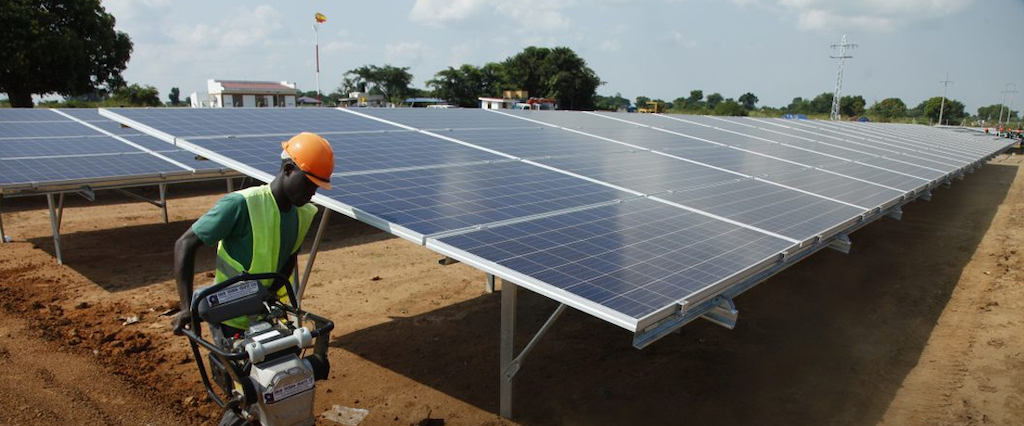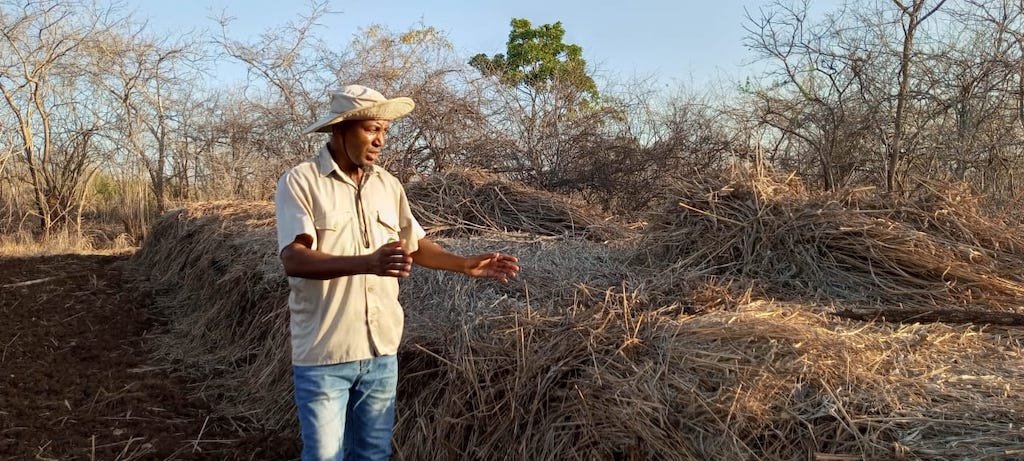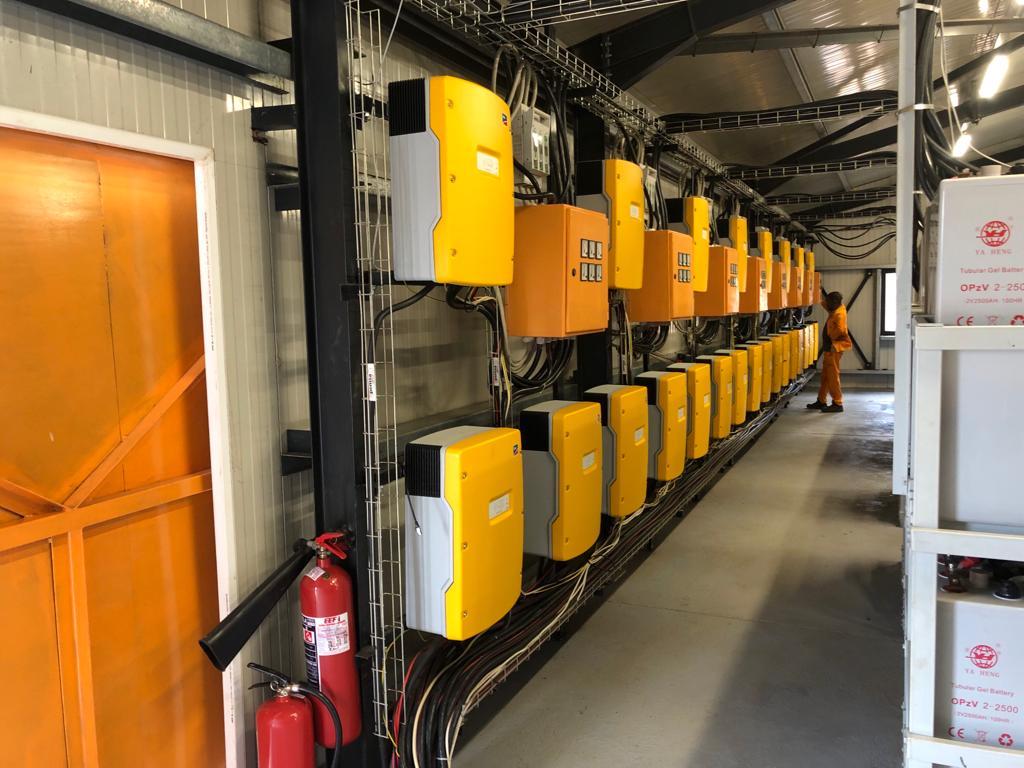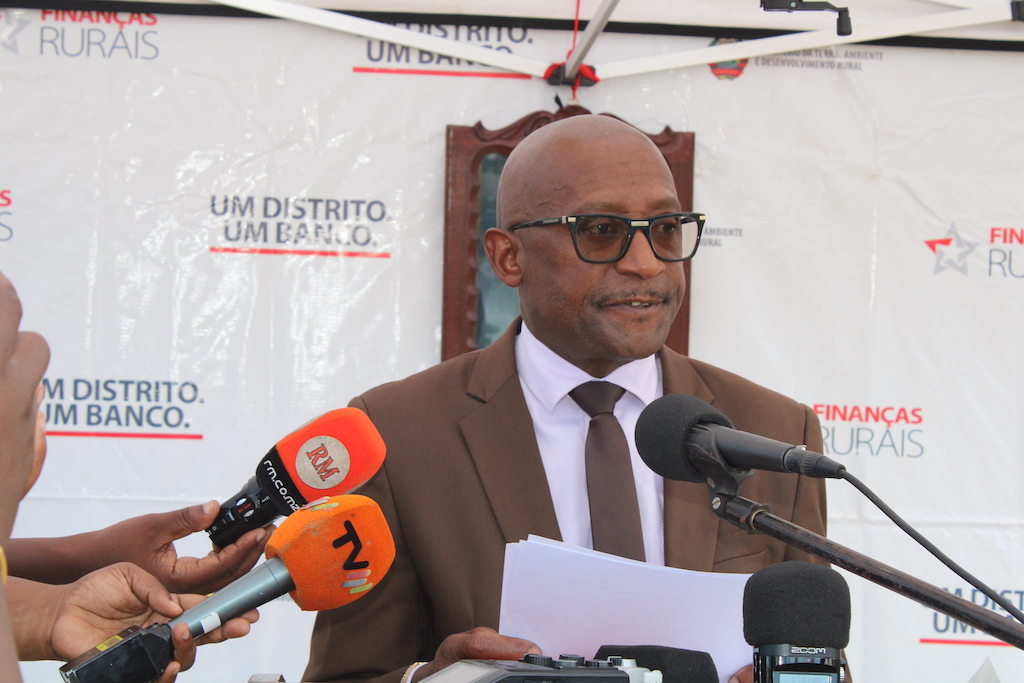
30 Oct Solar’s not shining for all in Cabo Delgado
Mozambique’s Energy for All programme has made great strides in far northern Mozambique, but not everyone is happy with it. Buanamade Assane investigates

The photovoltaic plant at Ngãpa produces 200kW, and was designed for 800 household connections. Photo: Buanamade Assane
Residents of Metoro district in Cabo Delgado province in northern Mozambique view the photovoltaic plant inaugurated in April 2023 by Mozambican President Filipe Jacinto Nyusi with some scepticism because they say they do not experience direct benefits or a reduction in energy costs.
Metoro is situated about 90km from Pemba, the capital of Cabo Delgado province, and constitutes the road axis that connects the mining district of Montepuez to the extreme northern border with Tanzania.
About 25 residents were relocated and compensated for their land to make way for the construction of the photovoltaic plant, according to locals.
Located in an area of 144ha and comprising 121,500 solar panels, the 41MW of photovoltaic power produced there is fed into the local substation of the national electricity supply network produced by Hidroeléctrica de Cahora Bassa (HCB).
Locals complain that they continue to pay the same amount or more for the electricity they use to the national electricity distributor, Mozambican Electricity Company (EDM).
At the launch ceremony in April, the National Energy Fund (FUNAE) announced that the plant had cost US$56-million and was designed to benefit 140,000 people. The project was a joint investment by EDM in partnership with Neoen, a French company, shared 25% and 75% respectively.
Public debt
Critics say this investment does not benefit Mozambicans but makes them “tighten their belts more” because it increases the public debt, taking into account that $40-million was a loan granted by the French Development Agency and the rest was the contribution of the Mozambican government. However, the plant will revert to EDM in 25 years’ time.
In Metoro, both businessman and ordinary citizens argue that, because the infrastructure was installed in their district, EDM – which holds a monopoly on the distribution of electricity at national level – should set a lower price for their electricity compared to other regions in the province, and as their social responsibility.
Two businessmen, speaking anonymously for fear of government reprisal, said they do not feel the benefits of the plant.
“I am paying the same rate that I was paying before this plant, but our uncles and brothers were forced to leave their farms in exchange for ‘peanuts’ to give space for the construction of the plant,” said a trade operator.
A hotel owner said his business continued consuming electricity supplied from the Cahora Bassa hydroelectric plant “and the prices charged have not changed. So what was the point of having the solar plant here?
“We expected that all the Metoro residents would have cheap energy, but we were wrong. So it means there is no advantage for us,” he said.
Information released during the opening ceremony shows that, during the construction phase of the solar plant, 400 jobs were created, with 90% of the labour being local.
However, Casal Arlino, who lives about 50m from the gates of the photovoltaic plant declared that he had no benefits from the energy infrastructure, despite having “eaten” a lot of dust during the construction phase resulting from the movement of vehicles.
“I’ve been a bricklayer for a long time but I wasn’t invited to work at the plant, maybe because I’m old, but I have a young son who didn’t even have access to a job.
“I saw it being finished and I don’t even have electricity. We are here living in the dark,” he said.

According to FUNAE, the expansion of green energy is gaining ground in Cabo Delgado. Photo: Buanamade Assane
Energy for All
President Nyusi stated at the opening ceremony that the Metoro plant constituted a catalyst for the ongoing electrification expansion of administrative posts within the scope of the country’s Energy for All programme, benefiting schools, health units and boosting the local economy.
The Metoro plant is an important milestone in the implementation of medium-scale renewable energy projects linked to EDM, which represent 25% of the energy that will be consumed in the northern region of the country, he added.
According to FUNAE, the expansion of green energy is gaining ground in Cabo Delgado, and there are currently six photovoltaic plants in the province. Three public plants are operational, producing a combined 333KW, and one at Mecúfi is on hold due to financial constraints.
Twigg Exploration and Mining, which operates the Balama Graphite Operation in Cabo Delgado, installed a plant with a capacity of 10.25MW to meet its energy needs.

Agricultural engineer Icbal Morripa at a charcoal oven in Metoro. The solar plant needs to be protected against uncontrolled burning, he says. Photo: Buanamade Assane
Environmental costs
At Metoro the large solar panels were supposed to act as rainwater collectors. Drainage ditches were built to direct the rainwater, but they have caused deep ravines on the site because construction has been halted for almost a year, due apparently to uncontrolled forest fires that burnt part of the equipment.
Icbal Morripa, an agricultural engineer, said the project was designed to collect water and concentrate it in a dam to supply the population and irrigate agricultural fields. “The power plant construction began in 2020 and was completed the following year, but it has already produced this size of ravines. What will happen in five or 10 years?”
“Urgent precautions are needed because in the surrounding area there are farms and people may find themselves having difficulty crossing the deep ravines to reach their farms, taking into account age or health conditions,” Morripa said.
He also noted that Metoro is a water-scarce district, so the plant needs an efficient water storage system to encourage the production of vegetables around the plant, which would help create a protective belt against uncontrolled fires, “to avoid situations of standstill as is happening now”.

The Ngãpa plant powers three health units in the district. Photo: Buanamade Assane
Lever for development
At Ngãpa further north, residents describe their photovoltaic plant as a lever for socio-economic development and say it is helping them move from primitivism to modernism.
The Ngãpa administrative post is located 56km from the town of Mueda, and the photovoltaic plant opened in April with an investment of US$187-million (12-million meticais) financed by FUNAE produces 200kW. It was designed for 800 household connections, and is currently running at 50% of its potential.
Residents as well local authorities say the socio-economic and environmental impacts are positive. Proximity to the plant does not bother the residents because it is clean energy.
One resident, Muanajuma Abdala, said he was satisfied with the price they are charged for electricity by EDM: “We are grateful for the installation of this solar energy, especially for the price charged because it takes into account the age of the consumer, those who have household appliances, etc. So we have radios, televisions, freezers. My life has changed a lot,” said Abdala.
Businesspeople Armando Laia and Laura Assumane said the plant helped them to conserve fresh fish and livestock products. “This energy brought joy. Now we live well. For those who have a freezer, they can bring fresh fish and chicken that they buy in Mueda to sell here,” said Assumane.
Traders Ija Mussa and Kane Armando said commercial activities have increased with electricity and lights in the local market. In the past, they said, business at the market closed at 5pm but now they can have customers until around 10pm every day. “Now I can keep the tuna and mackerel I buy in Montepuez and the stone fish from Mocimboa da Praia fresh,” stated Mussa.
The head of Ngãpa administrative post, Paulo Samuel Nankulanga, described the region as potentially rich for agricultural development. It is inhabited by a young and hard-working population, he added, and in the short time since the photovoltaic plant came into operation has been energised by commercial activity.
“Before, in the Ngãpa administrative post we lived like our ancestors, but today things have changed because we now use solar energy,” Nankulanga said.
The government official mentioned that the services of the three health units have improved because of better conditions for preserving vaccines and assisting night births in the maternity wards.
The mobile phone network now operates 24 hours a day, he said, which previously happened only during certain periods due to the operator’s high operating costs resulting from having to use a diesel generator.

Norte Luali, director of Provincial Infrastructure Services in Cabo Delgado. Photo: Buanamade Assane
In the dark
The Negomano administrative post, 185km from the main town of Mueda, remains in the dark and prospects of power from the national energy network appear remote due to the distance and the high costs of extending the electricity network. In this case solar energy would be a solution.
In an interview, Assamo Omar, the district permanent secretary, said Mueda has five administrative posts and only Negomano is in the dark. Solar plants provide the solution to achieve the “Energy for all” goal by 2030, he said.
“The impacts of solar energy are positive. The photovoltaic plants brought enormous satisfaction for the people and we would like to have identical projects being expanded to some locations where the national energy network is not enough,” Omar said.
Because solar energy is clean and low-cost, it is appropriate for rural communities, he added. With a 50 meticais (about $0,78) recharge it can be used for 15 days of consumption, depending on the number of connected household appliances.
In the town of Mpaka, there is a small photovoltaic plant that produces power benefiting just over 600 families. Estefania Buruhane and Jose Raibo, some of the beneficiaries of solar energy from the Mpaka Plant, said they are satisfied with the cost.
Buanamade Assane is a Mozambican journalist at Jornal Horizonte. This investigation was completed with the support of the Oxpeckers Investigative Environmental Journalism #PowerTracker project and the Centre for Investigative Journalism’s Open Climate Reporting Initiative.
You can find the dataset used for the investigation in the Oxpeckers Get the Data section here
